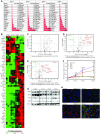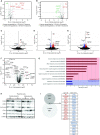Maternal Iron Deficiency Modulates Placental Transcriptome and Proteome in Mid-Gestation of Mouse Pregnancy
- PMID: 33693820
- PMCID: PMC8112763
- DOI: 10.1093/jn/nxab005
Maternal Iron Deficiency Modulates Placental Transcriptome and Proteome in Mid-Gestation of Mouse Pregnancy
Abstract
Background: Maternal iron deficiency (ID) is associated with poor pregnancy and fetal outcomes. The effect is thought to be mediated by the placenta but there is no comprehensive assessment of placental responses to maternal ID. Additionally, whether the influence of maternal ID on the placenta differs by fetal sex is unknown.
Objectives: To identify gene and protein signatures of ID mouse placentas at mid-gestation. A secondary objective was to profile the expression of iron genes in mouse placentas across gestation.
Methods: We used a real-time PCR-based array to determine the mRNA expression of all known iron genes in mouse placentas at embryonic day (E) 12.5, E14.5, E16.5, and E19.5 (n = 3 placentas/time point). To determine the effect of maternal ID, we performed RNA sequencing and proteomics in male and female placentas from ID and iron-adequate mice at E12.5 (n = 8 dams/diet).
Results: In female placentas, 6 genes, including transferrin receptor (Tfrc) and solute carrier family 11 member 2, were significantly changed by maternal ID. An additional 154 genes were altered in male ID placentas. A proteomic analysis quantified 7662 proteins in the placenta. Proteins translated from iron-responsive element (IRE)-containing mRNA were altered in abundance; ferritin and ferroportin 1 decreased, while TFRC increased in ID placentas. Less than 4% of the significantly altered genes in ID placentas occurred both at the transcriptional and translational levels.
Conclusions: Our data demonstrate that the impact of maternal ID on placental gene expression in mice is limited in scope and magnitude at mid-gestation. We provide strong evidence for IRE-based transcriptional and translational coordination of iron gene expression in the mouse placenta. Finally, we discover sexually dimorphic effects of maternal ID on placental gene expression, with more genes and pathways altered in male compared with female mouse placentas.
Keywords: gene expression; iron deficiency; iron metabolism; placenta; proteomics.
© The Author(s) 2021. Published by Oxford University Press on behalf of the American Society for Nutrition.
Figures



References
-
- Vos T, Abajobir AA, Abate KH, Abbafati C, Abbas KM, Abd-Allah F, Abdulkader RS, Abdulle AM, Abebo TA, Abera SF, et al. , Global, regional, and national incidence, prevalence, and years lived with disability for 328 diseases and injuries for 195 countries, 1990–2016: a systematic analysis for the Global Burden of Disease Study 2016. Lancet. 2017;390:1211–59. - PMC - PubMed
-
- De Benoist B, Cogswell M, Egli I, McLean E. Worldwide prevalence of anaemia 1993–2005. Geneva: WHO Global Database of Anaemia; 2008.
-
- Viteri FE. The consequences of iron deficiency and anemia in pregnancy. Adv Exp Med Biol. 1994;352:127–39. - PubMed
Publication types
MeSH terms
Substances
Grants and funding
LinkOut - more resources
Full Text Sources
Other Literature Sources
Medical
Molecular Biology Databases
Miscellaneous

